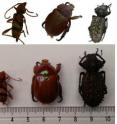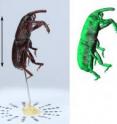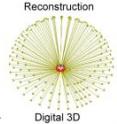'Off-the-shelf' equipment used to digitize insects in 3-D
Related images
(click to enlarge)
Scientists have developed a cost-effective, off-the-shelf system to obtain natural-color 3D models of insects, according to results published April 23, 2014, in the open access journal PLOS ONE by Chuong Nguyen from CSIRO in Australia, and colleagues. Scientists studying insects rely on collected specimens that are often shared between scientists through written descriptions, diagrams, and images. These 2D tools are important in understanding and sharing specimens, but they often lack the precise detail of the actual 3D specimen. The authors of this study, interested in understanding the feasibility of digitizing insects for research purposes, created a cost-effective prototype to produce 3D naturally colored digital models of medium-to-large insects (3 to 30mm in length), using off-the-shelf equipment and software. The prototype captures color images from different angles and focal depths using a digital single lens reflex camera and a two-axis turntable. These 2D images are then combined into 3D reconstructions.
The resulting 3D models are compact (around 10 megabytes each), have excellent optical resolution, and can be embedded into documents and web pages, as well as viewed on mobile devices. The authors suggest the system is portable, safe, relatively affordable, complements existing imaging techniques, and reduces the need to handle or ship delicate insect specimens. Furthermore, they hope that this technology opens new opportunities and applications for research data collection, education, art, entertainment, biodiversity assessment, and biosecurity control.
Dr. Nguyen added, "These 3D models represent high quality visualisations of physical specimens that will enable novel solutions to quickly extract, analyse and share rich information. The 3D models are of great value for biodiversity discovery, species identification, quarantine control, and unlocking big data in our biological collections."
Source: PLOS
Other sources
- 'Off-the-shelf' equipment used to digitize insects in 3-D: Model insects useful for studying, sharing specimensfrom Science DailyThu, 24 Apr 2014, 22:32:46 UTC
- 3-D Insect Models by New Scanning System Reveal True Color | Videofrom Live ScienceWed, 23 Apr 2014, 23:01:31 UTC
- Tiny Insect Parts Revealed in New 3D, True-Color Imagesfrom Live ScienceWed, 23 Apr 2014, 23:01:19 UTC
- 'Off-the-shelf' equipment used to digitize insects in 3-Dfrom PhysorgWed, 23 Apr 2014, 21:00:57 UTC


